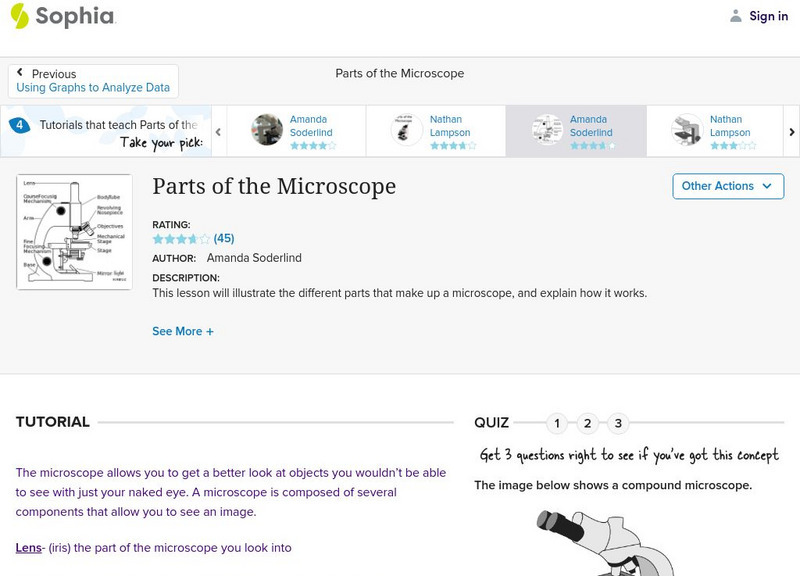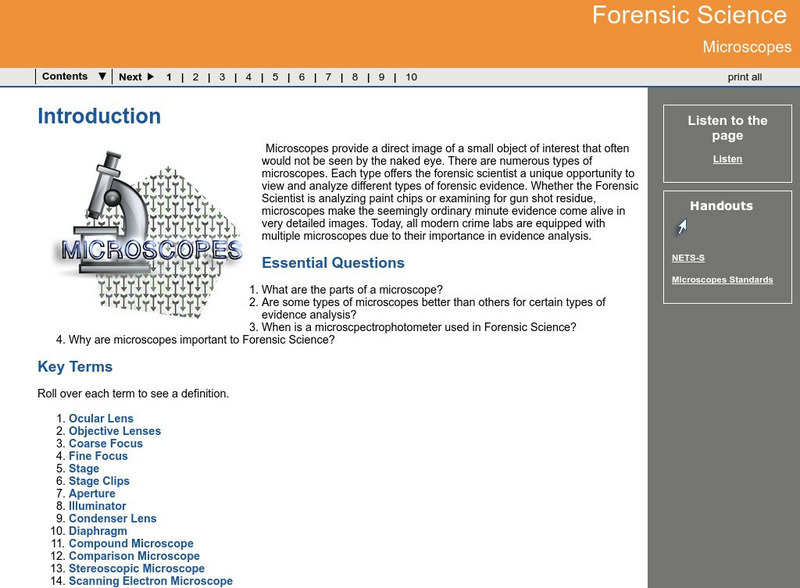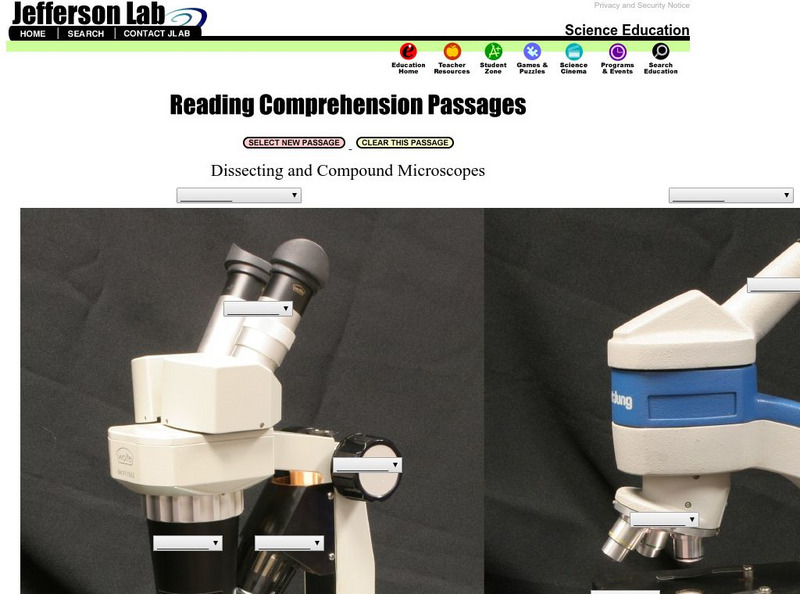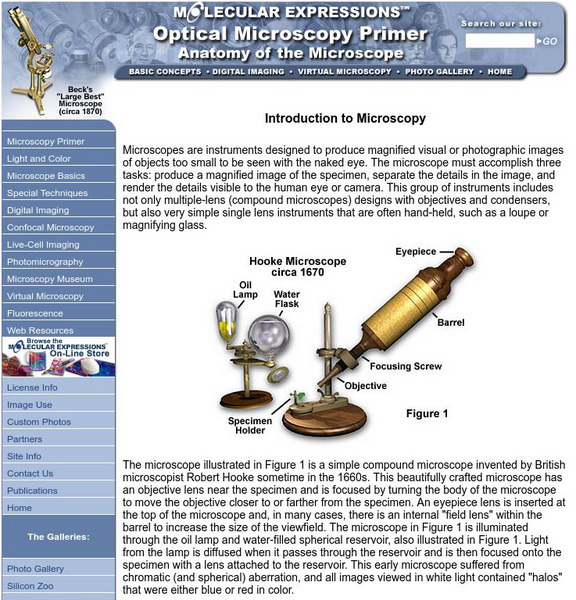Hi, what do you want to do?
Curated OER
Collect Your Own Drosophila Lab
Students study Drosophila by catching them. They construct catcher-containers to catch Drosophila using fruit as bait. After collection, they examine the flies and collect data to be displayed.
Curated OER
Pond 1: Pond Life
Pupils work together to investigate familiar and unfamiliar ecosystems. Using the internet, they discover how different organisms use their environment to satisfy their needs. They also examine the relationshiops between organisms and...
Curated OER
Ecosystems
Sixth graders perform various labs, create presentations, and do hands on activities to explore the ecosystem.
What2Learn
What2 Learn: The Parts of a Microscope
An activity where students can use the interactive diagram to label the major parts of a microscope.
Sophia Learning
Sophia: Parts of the Microscope: Lesson 4
This lesson will illustrate the different parts that make up a microscope, and explain how it works. It is 4 of 4 in the series titled "Parts of the Microscope."
Science Struck
Science Struck: A Study of the Microscope and Its Functions
Uses illustrations with labels to complement a detailed examination of the parts and functions of a light microscope and an electron microscope.
Georgia Department of Education
Ga Virtual Learning: Microscopes and Forensic Science
In this comprehensive interactive tutorial you will learn about the parts of a microscope and how some types of microscopes are better than others for certain types of evidence analysis within the field of Forensic Science. A...
Georgia State University
Georgia State University: Hyper Physics: Microscope
This site from Georgia State University Physics Department provides a discussion of how light refracts through the lenses of a microscope. Demonstrates the parts of a microscope and includes an interactive form in which the magnifying...
ClassFlow
Class Flow: The Parts of the Microscope
[Free Registration/Login Required] Following the lesson, students will be able to identify the different parts of a microscope.
Sophia Learning
Sophia: Parts of the Microscope: Lesson 2
This lesson will illustrate the different parts that make up a microscope, and explain how it works. It is 2 of 4 in the series titled "Parts of the Microscope."
Sophia Learning
Sophia: Parts of the Microscope: Lesson 3
This lesson will illustrate the different parts that make up a microscope, and explain how it works. It is 3 of 4 in the series titled "Parts of the Microscope."
Science Struck
Science Struck: Light Microscope vs Electron Microscope: A Comparison
Looks at the differences and similarities between a light microscope and an electron microscope. Discusses their structure, how images are formed, their resolution and magnification, how color is manifested, their portability, cost, and...
Other
University of Delaware: Virtual Compound Microscope
This virtual microscope is ideal for learning how to properly use a microscope. Users can turn knobs and dials, throw switches, move levers, change lenses, select a specimen, and adjust oculars. Watch the seven minute video for an...
PBS
Pbs Learning Media: Microscope Activity
Explore the parts of a compound microscope and view cells through this interactive lesson.
Biology Corner
Biology Corner: Microscope Parts Quiz
This interactive diagram helps students memorize the parts of a light microscope.
Thomas Jefferson National Accelerator Facility
Jefferson Lab: Reading Passages: Disecting and Compound Microscopes
Read and fill in the blanks on these pictures of microscopes with the correct part names. Each blank has a dropdown menu with choices. When you finish, click CHECK MY ANSWERS. If you pick a wrong answer, the right answer will be...
Other
Scimat: Foods Under the Microscope
A technical site that describes different types of microscopes and delves into the chemical makeup of milk, yogurt, various various types of microorganisms. Impressive pictures supplement the text. Links to images of microorganisms.
National Science Foundation
National Science Foundation: A Tour of the Cell
Imagine having a microscopic camera so small that you could travel inside a cell. This interactive site allows you to do just that. Click on any one of eight individual parts of the cell--cell membrane, nucleus, DNA, RNA, ribosome,...
My Science Site
Bj's Science: Microscope Diagram [Pdf]
Site is simply a picture of a microscope that has numbers that correspond with each part of it. No answers are provided. A good reproducible if you are looking for a detailed view of the different microscope parts.
Science Struck
Science Struck: The Compound Microscope Parts and Its Functions
Goes through the different structural and optical parts of a compound microscope and how a compound microscope functions.
Other
Southern Microscope Service's Home Page
A series of pages explaining how microscopes work, the parts of a microscopes, the techniques of using a microscope, and other useful information.
Huntington Library
Huntington Library: Garden Lesson Plans: Investigation: Pollen Collection [Pdf]
After learning about what pollen is, its health effects, as well as how it benefits humans, students take part in a lab activity. For this, they collect schoolyard pollen on slides, stain it, and then examine it under a microscope.
Florida State University
Florida State University: Introduction to Microscopy
A thorough introduction to the structure and function of microscopes. Identify types and parts of the scientific tool. Utilize interactives to strengthen understanding.





















